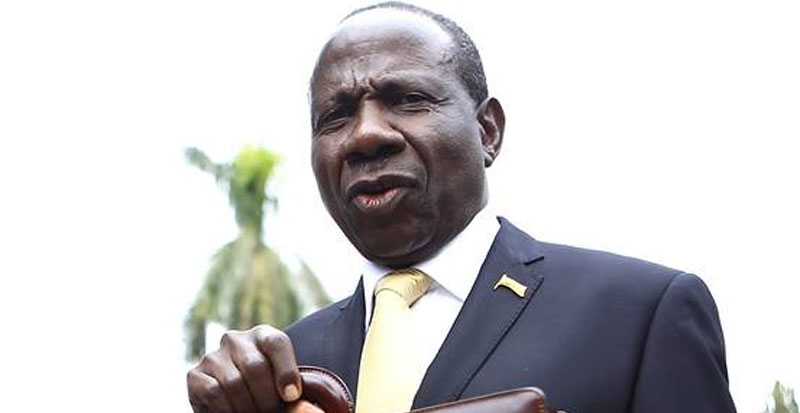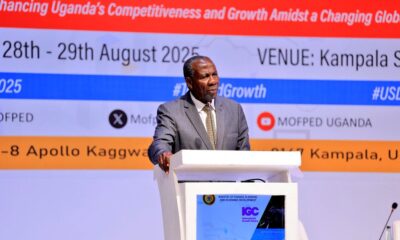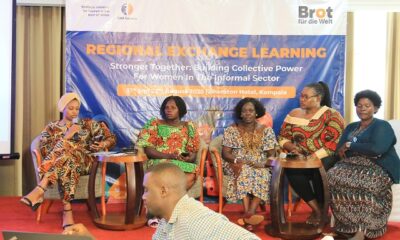Columnists
How to make the 2019/20 budget benefit the people
MPs re-allocate the funds going to be spent wastefully to wealth creation and service delivery

Minister of Finance Matiya Kasaija will soon read the 2019/20 budget
As a norm, government annually sets priorities and allocates resources for implementing these priorities. The policy document through which these priorities are set and expected revenues and spending proposed is the national budget.
The budget is also the single most important mechanism used by government to influence social, economic and political life of the people. Uganda’s budget process has for years been commended for being participatory, transparent and efficient.
Authorities at Ministry of Finance, Planning and Economic Development (MoFPED) say our budget is formulated under four key arrangements: the sector-wide approaches (SWAps); the medium-term expenditure framework (MTEF); the poverty action fund (PAF); and the fiscal decentralisation process, all of which are anchored on the national development plan (NDP), now its second edition.
With the MTEF marrying a top-down and bottom-up decision-making process that reconciles costs and new policy ideas with available resource envelop, on paper one would struggle to find a well-thought budget process than Uganda’s.
The law (the Public Finance Management Act, 2015) under which the budget process is prepared is a well legislated legal framework. Issues such as gender and equity responsiveness are often debated in Parliament before the budget is passed. The share of the “development budget” relative to the “recurrent budget” allocations has increased over the years.
Domestic resources (as a percentage of the budget) have also increased and donor funding (particularly granted dwarfed). Uganda’s budget is often largely consistent with the “charter of fiscal responsibility” and compliant with the NDP.
What’s wrong with Uganda’s budget?
So, with all these in mind why would anyone fault Uganda’s national budget? Has it failed to deliver growth? Uganda’s economy has for years been one of the fastest growing in the region, save for the recent few years when growth fell below the target. It has since recovered to over 6%.
Well, beyond the above-mentioned strengths one needs to ask the fundamental question: is Uganda’s budget transformative? Is the budget aligned to the economy’s desired transformational needs? Does the budget address the causes of Ugandan economy’s failure to complete the socio-economic structural transformation?
What needs to be done to facilitate economic transformation in Uganda? How best could Uganda budget for economic transformation, job creation and socio-economic inclusion?
On the last day of April 2019, the MUBS Economic Forum (an economic think-tank for Makerere University Business School), in partnership with Friedrich-Ebert-Stiftung (FES), organised a public dialogue to discuss how Uganda’s budget could be refocused to achieving economic transformation and social inclusion.
I presented a paper that made a careful review of the legal and policy documents and analysed the 2019/20 budget. First, the paper shows the budget process is practically not what it appears to be on paper. Second, it finds that Uganda’s budget is not transformative. It pursues growth without transformation, and that the political economy under which the budget is designed is suffocating its ability to create wealth and deliver services to Ugandans.
What’s economic transformation?
Economic transformation is change in the structure of the economy from a subsistence economy to an industrial and advanced society. It’s the defining characteristic of the development process; both the cause and the effect of economic progress.
Four interrelated processes define transformation: 1) a declining share of agriculture in gross domestic product (GDP) and employment; 2) rise of a modern industrial and service economy; 3) rapid process of urbanisation (rural to urban migration); and 4) a demographic transition from high to low rates of births and deaths.
Four main factors contribute to transformation: a) technology-led productivity growth i.e. “creative destruction” in all sectors – people adopting new ways of accomplishing tasks and abandoning the old ones (in farming, house work, industry etc.); b) rapid capital accumulation through increased saving and investment; c) role of linkages – between agriculture and non-agriculture sectors; and d) role of markets, institutions, and government.
Rapid industrialisation has historically been the precursor of economic transformation. No country has ever transformed from a peasant subsistence economy to an industrial and advanced society without developing the industry particularly manufacturing.
In his book, “What is Africa’s Problem?” published in 1992, President Museveni writes on page 208, “There is no way that Africans can emancipate themselves from poverty and backwardness without carrying out an industrial revolution. As long as we continue exporting cheap, raw, primary commodities, our present situation will not change.”
How is Uganda performing on transformation?
Uganda’s economy has been growing without transformation. The bulk of Ugandans are still self-employed and in agriculture. The share of the working population in formal sector businesses is very small, only 3%, while the share in formal sector manufacturing is even smaller, a negligible 0.7%.
Uganda has the largest proportion of rural population in East Africa, 82% and the few people in urban areas are mainly employed by the urban informal sector (9 of 10 Ugandans). Only 22% of Ugandans, on average, have access to electricity, with some places like Karamoja having a paltry 0.6% access.
Uganda has failed to complete demographic transition. We have the second lowest death rate in East Africa (12 persons per 1000 – after Kenya’s 10 persons per 1000), but also we have the highest birth rate (48 persons per 1000).
Ugandans are still producing children using calculus – “let me produce six; three might die and I remain with the three.” Yet children no longer die the way they used to; hence all the six survive and exert a huge dependency burden on the parents.
Growth without jobs
In addition, Uganda’s growth profile has remained jobless. There is only one job for every 500 qualified applicants! Incomes too have not kept pace with the GDP growth, while inequality is rising.
Empirical research shows Uganda’s growth has mainly been due to productivity growth within sectors, with movement between sectors undermining growth. The services sector has been the largest contributor to economic growth in Uganda. However, contribution by services has been due to rising worker productivity within the sector and not due to structural change towards services.
Structural change has accounted for only 18% of Uganda’s growth, the rest (82%) is on account of within sector growth (in services and industry). Agriculture has had negative within sector growth, yet it the largest employer of Ugandans.
Workers are shifting from other sectors to agriculture (inter-sectoral shifts) leading to a decline in productivity in agriculture. One economic tragedy that is silently unfolding in Uganda is the elite’s return to land.
It has become fashionable for every elite in Uganda to introduce themselves as farmers. And since agriculture is being touted as the ‘backbone for the economy’, many people think it is actually a good thing for the educated professionals (engineers, lawyers, doctors, accountants etc.) to go back to their villages and practice farming. Not at all.
Countries transform when people graduate off land into modern sectors (industry and modern services) and they don’t return to compete with peasants in villages. The professionals should be building factories and modern services (hotels, call centres, stores etc.) to employ the peasants. In the process, land is freed as more people move to urban centres to work in the factories/services to enable large-scale commercial farming to feed the urban population.
That what success stories such as Vietnam, Thailand, India are doing. Transformation in such countries has been made possible by structural change away from agriculture and demographic change.
When is the budget transformative?
So, what role can the budget play to facilitate structural change and economic transformation in Uganda? For a budget to be transformative it must do the following:
First, it must invest in sectors that encourage structural change towards higher productivity sectors and jobs, that is, industries especially manufacturing firms not processing plants per se, as well as modern services.
Second, it invests in technological upgrading to achieve productivity growth within sectors e.g. irrigation and fertilizer to boost agriculture, and also industrial upgrading.
In addition, it employs industrial policy that takes explicit account of job quality, quantity and access. It also invests in improved education quality and training, social protection services, increases access for disadvantaged, vulnerable and other groups of society to economic opportunities. the budget should also be concerned with micro-level, rather than macro-level transformations.
It prioritises livelihood transformation from non-paid employment and self-employment in agriculture to (a) self-employment in the non-agricultural sectors; (b) wage and salaried work in agriculture; and (c) wage and salaried employment in non-agricultural sectors.
A peep into the 2019/20 budget
The 2019/20 budget totalling nearly UGX 40 trillion is clearly not transformative. First, its strategy focuses on increasing the growth of the economy as if when the economy was growing it transformed. It does not focus on facilitating the economy to transform.
The theme of the budget, “Industrialisation for Job Creation and Shared Prosperity”, is spot on. True the budget mentions commercialisation of subsistence agriculture; growing exports and substitution of import; lowering the cost of doing business and credit; and creation of jobs as its pillars. However, analysis of allocations both at sector and program/output levels defeats its meaning.
First, the sectors that would help achieve most of the things mentioned in the strategy were allocated peanuts. The lion’s share of the budget allocations has been given to sectors that would drive growth without transformation.
A quarter of the budget goes to debt servicing which jeopardises any form of social transformation. Although a big chuck of the borrowed money is invested in infrastructure (roads and electricity), which is a good thing, two issues still defeat transformation:
Within sector allocations are highly consumptive. Ministries, Departments and Agencies (MDAs) are going to spend over UGX 2.8 trillion (9.2% of the appropriated budget) on the following items alone: allowances, travel, consultancies, special meals and drinks, car purchase, fuel, workshops and seminars, printing and photocopying, welfare and entertainment, public relations, and hire of venues.
Secondly, disbursement of the loans is still weak. As at December 31, 2018, the undisbursed loans totalled USD 4.34 billion (UGX 16,047 billion), some as old as 1985! This is due to slow implementation of projects.
Now that the budget is with Parliament, the MPs should ensure that funds going to be spent wastefully are re-allocated to wealth creation and service delivery. It should also ensure fiscal decentralisation, preferably through regional initiatives.
We have made a thorough analysis of the 2019/20 budget and identified over a trillion shillings which was illegally allocated to MDAs yet it should have gone to Local Governments and create more pro-people impact.
Comments





















